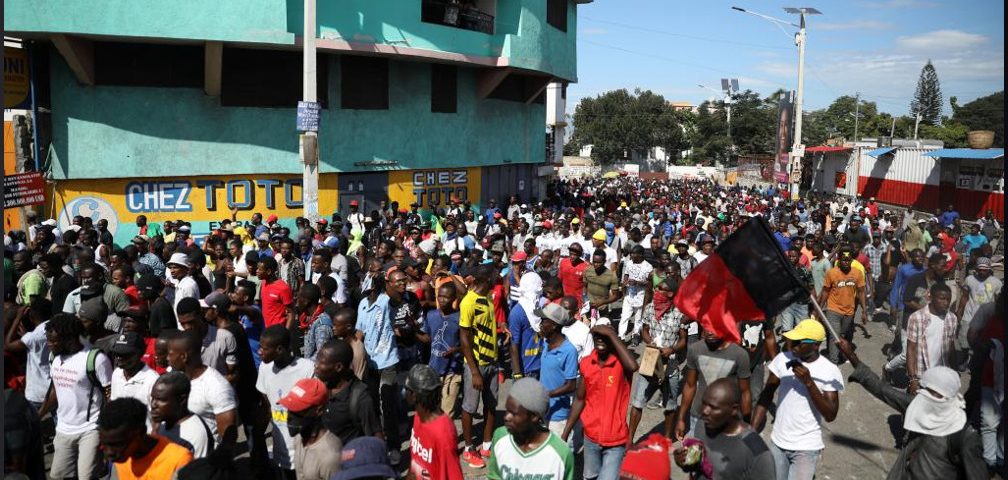Photo from TellerReport.com, Haitian youth demonstrate against the people in power. ~from TellerReport News
by Marty Goodman, from Socialist Action, November 11, 2018
Beginning Nov. 18 and for some six days, rebellion gripped Haiti. The Haitian masses jammed the streets, shutting down schools, transportation and businesses, some lighting bonfires of rubber tires at street corners or torching symbols of authority and corruption. At least 11 were killed, mostly by police, and 34 were injured. One cop died during the protests. A new force, likely paramilitary, was seen wielding M-60 machine guns, a weapon that can fire armor piecing bullets.
The trigger for the protests was the rip-off of close to $3.8 billion in Venezuelan aid given to Haiti in the form of a discounted gas program known as PetroCaribe, as revealed in a study by the Haitian Senate.
Protesters chanted, “Where did the PetroCaribe money go?” and “Moïse must go!”—referring to Jovenel Moïse, Haiti’s corrupt, pro-U.S. president. Thus far, the Moïse regime, which was elected with only 600,000 votes amidst charges of fraud, has refused to step down or investigate the theft of PetroCaribe funds. Moïse, whose finances were already under investigation for money laundering upon taking office, is suspected of being implicated in the PetroCaribe scandal, along with his network of crooked friends and business partners.
The Organization of American States (OAS), as perpetual servants of U.S. policy, issued a statement lashing out at protesters, while in solemn tones calling for “dialogue.” For now, at least, dialogue is rejected by the opposition. According to oppositionist Me André Michel,
“There is only one option. Jovenel Moïse is a political corpse that must be brought to the cemetery. It’s over for him. We cannot do anything with him anymore. He must leave without delay to avoid chaos.”
Nov. 18 was the 215th anniversary of the Haitian slave victory over French colonialism at the Battle of Vertieres, led by Haitian revolutionary hero Jean-Jacques Dessalines. This year, out of fear of being greeted by unruly protests, the president broke with the tradition of going to Cap Haitian to observe the anniversary and went instead to Port au Prince, the capital, for a low-profile observance.
The disappeared PetroCaribe billions could have gone toward creating desperately needed jobs to build schools, hospitals, and decent housing for Haitians, who must live on an average of less than $3.15 a day in a country with an unemployment rate of about 40%.
In a panic, Prime Minister Jean-Henry Céant announced creation of an estimated 50,000 temporary jobs until the end of the year. For the “opposition’s” part, Haitian Senator Evaliere Beauplan, a member of the Democratic and Popular Sector, met with at least one Trump representative on Nov. 21 to discuss the crisis—i.e., to misdirect and deceive the Haitian masses. Beauplan was an author of the Haitian Senate study on the PetroCaribe scandal.
More than two centuries of U.S. imperialism have kept Haiti a neo-colony that has nurtured its corrupt elite. Today, Haiti is occupied by the UN Mission to Support Justice in Haiti (MINUJUSTH), about 1200 armed UN police officers who occupy key positions and advise or dictate armed intervention. The U.S.-dominated UN is the final authority in Haiti, not Haitians, and can deploy 10,000 troops at any time.
The protests were called by coalitions of opposition forces, including some 50 political parties; among them were former supporters of Jean-Bertrand Aristide. But none have called for an end to U.S. occupation and domination.
Berthany Dupont, editor of Haiti Liberté, a weekly, told Socialist Action that while the paper supports the protest demands, it strongly rejects what Dupont called the opposition’s “bourgeois parties’” refusal to call for the U.S./UN to get out of Haiti, without which, he said, “we’re going back to the same thing.”
The November mobilizations are the third mass outpouring since last July 6-8, when the Haitian masses poured into the streets to resist President Moise’s order to virtually double gas prices at the behest of the International Monetary Fund (IMF), the gangster-like enforcement arm of the U.S.-dominated World Bank, in exchange for a $96 million loan to Haiti. In July, Haitians blocked roads, burned tires, discharged guns, and wrecked some 80 stores, including torching three super-markets owned by Reginald Boulos, president of the national chamber of commerce and industry of Haiti. As many as 20 people were killed and over 50 arrested. Haitians have called the World Bank/IMF plans “the death plan.”
On Oct. 17, tens of thousands took to the streets across Haiti in huge protests. Some observers say it was even bigger than Nov. 18. It was a holiday for workers because it marks the day when revolutionary leader Dessalines was killed in 1806. Of the 10 departments in the country, only Nippes did not see large marches. At least eight were killed Oct. 17 by Haitian cops.
Following an Oct. 31 funeral for six of those killed Oct. 17, held in a church in the Bel-Air slum in Port au Prince, a march was organized and grew into a protest against the PetroCaribe corruption. During the march, one man was shot dead and at least eight others were injured.
The desperation and mobilization of the Haitian masses is at an acute stage. The leadership of middle-class and ruling class forces will offer no solution to the misery in Haiti. A complete transformation of Haitian society is needed, that is, the elimination of imperialism and capitalism. Hope lies with the forces seeking revolutionary change.
Marty Goodman is a former board member of the Haitian Refugee Center of Miami. He witnessed the fall of Haitian dictator “Baby Doc” Duvalier in 1986 and was an official election observer in the 1990 election of former Haitian President Jean-Bertrand Aristide. He opposed the US/UN occupation of Haiti and is a member of the ‘Black Lives Matter in the Dominican Republic’ committee. Goodman is also a member of Socialist Action.
